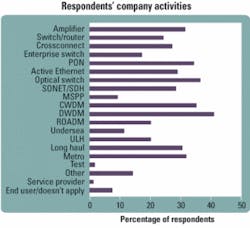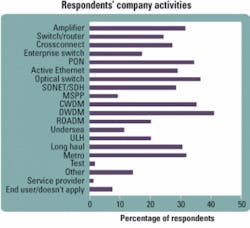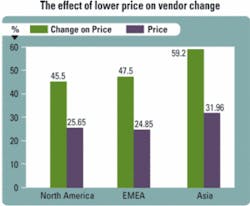Readers reveal transceiver/transponder purchase factors
by Stephen Hardy
How well do you know your customers? If you sell transceivers or transponders, the results of a study of Lightwave readers will either confirm your impressions or challenge your assumptions.
Lightwave conducted the reader survey this past February with the help of market and media research company Advantage Business Research (ABR; www.advantage research.com). We e-mailed a questionnaire to a pool of approximately 3,000 readers who had identified themselves as purchasers of transceivers and transponders when they subscribed to the magazine. The subsequent response base of just under 10% provided us with results that bore a margin of error no greater than ±5.8 percentage points at a confidence rate of 95%, ABR assured us.
The respondent base covered a wide range of demographics. For example, 52.3% of the respondents work in North America; 23.3% in Europe, the Middle East, or Africa (EMEA); 18.7% in Asia; and the rest from such diverse locations as Australia and Latin America. Not surprisingly, most survey participants (39.5%) work for companies primarily involved in systems/subsystems design and development, followed by carriers/service providers (21.3%), systems integrators (17.8%), and university/R&D (11.2%). As Fig. 1 illustrates, our respondents work at companies that make a wide variety of products for optical networking.
When we asked our readers what they look for in a product and a supplier, we discovered that purchasers have consistent ideas about what they want.
While cost reduction demands continually dog suppliers, veterans of purchaser surveys such as Lightwave’s will not be surprised to learn that our respondents claim that price isn’t the most important factor when choosing a transceiver/transponder for their applications. Rated on a scale of 1 to 10, with 1 being “Not at all important” and 10 being “Extremely important,” reliability (a mean of 8.99) and performance (a mean of 8.90) topped the purchase criteria list. Cost came in third, with a mean score just above customer service (8.29 versus 8.19).
Second-tier criteria tended to focus on the characteristics of the potential supplier. These factors included the perception that the manufacturer represented a stable production source (a mean of 7.98, which makes it the most important such characteristic), the fact that the supplier is an established vendor (7.30 mean), and the purchaser’s previous experience with the supplier (7.23 mean). Secondary product aspects included form factor (7.15 mean), availability of a second source (7.09 mean), power consumption (6.98 mean), tunability (6.67 mean), and the fact that the product is customized for the application (6.20 mean).
The increasing globalization of the transceiver/transponder supply base was illustrated by the fact that the supplier’s country of origin rated only a 5.39 mean score. Meanwhile, the experience factor that rated a 7.23 mean doesn’t have to be current; the fact that a company is a current supplier to the respondent rated only a 5.99 mean.
Our respondents also seemed willing to keep an open mind when it comes to working with startups. Only 18.3% said they either definitely or probably would not work with a new transceiver/transponder company. Conversely, 36.1% said they either probably or definitely would work with such a vendor-which left 45.5% sitting comfortably on the fence.
Once a vendor manages to make a sale, it can’t rest on its laurels, our survey revealed. The respondents seemed willing to change suppliers, and there are several factors that could lead them to do so.
Transceiver/transponder buyers aren’t necessarily fickle, but they like to keep their options open, according to our survey results. Only 1.9% of our respondents said they definitely will not change suppliers once they’ve made a purchase decision; a more robust 31.7% said they “probably” will not. On the other hand, a combined 17.8% said they either “definitely” or “probably” will change. As with the startup question, the greatest percentage of respondents, 48.6%, chose “might or might not” when it comes to the possibility of swapping suppliers.
Fortunately for suppliers, most of the factors that would likely lead a customer to turn to a competitor are within their control. Failing on promised performance represents the most compelling factor for change, with 67.2% of respondents listing such an occurrence as a reason to look elsewhere. Missing delivery deadlines would be cause enough to trade in a supplier for 56.8% of our respondents, while not meeting price promises would compel 45.6% of those surveyed to engage a new supplier.
That said, the opportunity to poach customers is very real. For example, 45.9% of respondents said that they’d change vendors if someone else offered better performance, while 48.3% said they’d switch if someone offered them a better price. Of the latter respondents, a 27.3% reduction would be enough to catch their eye, on average. Perhaps surprisingly, Asian respondents confirmed their region’s reputation by being more likely than buyers in other parts of the world to change vendors because of price-but the price differential had to be greater than in other regions (Fig. 2).
Finally, 38.6% of respondents said that a redesign or other update of their product might lead to a change in suppliers.
With these purchase factors as a backdrop, we also asked our respondents their opinions of 30 transceiver/transponder vendors. We’ll reveal what they had to say in next month’s issue.Stephen Hardy is the editorial director and associate publisher of Lightwave.


